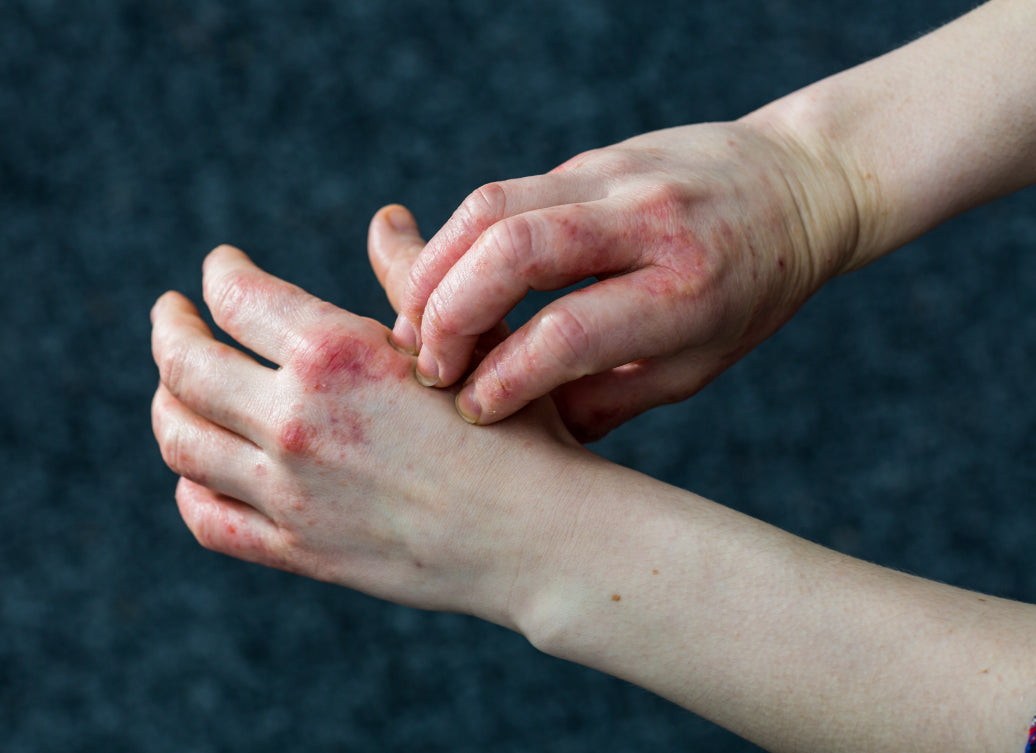Dyshidrosis can certainly look infectious, with its weepy blisters and sore skin, but it is really something you can pass on to other people?
What is dyshidrosis?
Dyshidrotic eczema is a chronic skin condition that generally affects fingers and/or toes, causing them to become first very itchy and painful, then to break out in tiny blisters under the skin, and finally for the skin to crack and start to dry up. These cycles of itchiness, blistering and then soreness and inflammation can be very hard to manage, with some people suffering almost constant outbreaks of dyshidrosis.
What are the symptoms of dyshidrosis?
The condition, also known as pompholyx, dyshidrosis, vesicular hand dermatitis or palmoplantar eczema, has various symptoms through its cycle, but usually follows this path:
- Burning, stinging sensation on the fingers or toes
- Intense itchiness
- Tiny, fluid-filled blisters under the skin
- Weeping or crusts
- Extremely dry, sore or cracked skin
- Inflammation and heat
- Scaliness or thickened skin
Does dyshidrosis spread?
Dyshidrosis can spread from fingers or toes to your palms or soles, sometimes even to the backs of your hands or feet in severe cases. It is very unlikely to spread beyond that, though.
However, it is not contagious, and can’t be passed on from person to person, so there’s no risk to anyone else, even with close contact.
Although dyshidrosis isn’t infectious, it can get infected. This is usually because the skin can get cracked in the last stage of its cycle, leaving it vulnerable to infection by bacteria that can be found on your skin, on surfaces or in the air. If your dyshidrosis gets infected, consult a doctor or pharmacist who can advise you on appropriate treatment.
There’s also an association between dyshidrosis and fungal infections; an overgrowth of yeasts on the skin seems to be a factor in flares of the condition, although it’s not clear whether dyshidrosis is caused by the fungal infection or just provides the right conditions for it.
Other infectious skin conditions
Although dyshidrosis is not contagious, it can look quite similar to other skin conditions which are infectious, and also have similar fluid-filled blisters. These include bacterial infections (like impetigo or eczema herpeticum) or viruses (like the various forms of herpes, chicken pox or shingles). It’s always a good idea to get blistering skin conditions checked out by a doctor for a definite diagnosis.
Managing dyshidrosis
Managing this complex and painful condition can be a difficult task. For more detailed information about how you can get on top of a flare, check out our article How Do You Get Rid Of Dyshidrotic Eczema?
The short version is that you need to keep your skin clean, dry, moisturised and away from irritants that can aggravate the condition, while also looking at whether your stress levels and diet are playing a part in the flare.
Recommended products for skin prone to dyshidrosis:
Balmonds Skin Salvation
(for the dry, cracked stages)
Balmonds Cooling Cream
(for itchy stage)
Balmonds Natural Shampoo & Body Wash
(to use instead of soap)
Balmonds Scalp Oil
(for clean, nourished skin)
